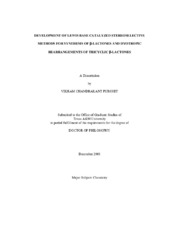| dc.description.abstract | The recent finding that the FDA-approved antiobesity agent orlistat (tetrahydrolipstatin, Xenical) is a potent inhibitor of the thioesterase domain of fatty acid synthase (FAS) led us to develop a concise and practical asymmetric route to
pseudosymmetric 3,4-dialkyl-cis-beta-lactones. The well-documented upregulation of FAS
in cancer cells makes this enzyme complex an interesting therapeutic target for cancer.
The described route to 3,4-dialkyl- beta -lactones is based on a two-step process involving Calter's catalytic, asymmetric ketene dimerization of acid chlorides followed by a facialselective hydrogenation leading to cis-substituted- beta -lactones. Importantly, the ketene dimer intermediates were found to be stable to flash chromatography, enabling
opportunities for subsequent transformations of these optically active, reactive
intermediates. Subsequent R-epimerization and R-alkylation or acylation led to trans- beta -
lactones and beta -lactones bearing alpha-quaternary carbons, respectively. Several of the ketene dimers and beta-lactones displayed antagonistic activity (apparent Ki in the low micromolar range) in competition with a fluorogenic substrate toward a recombinant
form of the thioesterase domain of fatty acid synthase. The best antagonist, a simple
phenyl-substituted cis- beta -lactone, displayed an apparent Ki (2.5 ( 0.5 muM) of only 10- fold lower than that of orlistat (0.28 ( 0.06 muM). In addition, mechanistic studies of the ketene dimerization process by Reaction View infrared spectroscopy support previous findings that ketene formation is rate determining. A highly diastereoselective, nucleophile-promoted bis-cyclization process,
employing readily available and tractable keto-acid substrates, is described. This
methodology provides concise access to bicyclic- and tricyclic-beta-lactones bearing
tertiary carbinol centers and quaternary carbons, greatly extending the scope of previous routes to bicyclic-beta-lactones from aldehyde acid substrates. This and related processes may be revealing a subtle interplay between [2 plus 2] cycloaddition and nucleophilecatalyzed aldol lactonization (NCAL) reaction manifolds. An early induction period in the bis-cyclization of keto-acids is confirmed via isolation of the complex between 4- pyrrolopyridine and Modified Mukaiyama reagent N-propyl-2-bromo pyridinium triflate.
Dyotropic rearrangements of tricyclic keto beta-lactones derived in high yields and
>19:1 diastereoselectivity from readily available 1, 3-dione acids is described. Zn (II) salts were found to be most efficient for affecting dyotropic 1, 2-acyl migrations where
as sub stoichiometric TMSOTf was found to execute a delta-lactone migration providing bis
gamma-lactone in modest yields. Enantioselective desymmetrization with inexpensive (S) - tetramisole has been demonstrated to provide direct evidence of Lewis base involvement in the Nucleophile Promoted Bis-cyclization of keto-acids. Further studies using TsCl as the carboxylate activating agent instead of modified Mukaiyama reagent and catalytic tetramisole are described for achieving practical, catalytic, enantioselective synthesis of beta-lactones from keto-acids. Preliminary studies toward conjugate addition- lactonization pathway provided a hint as to the complexity involved to affect this transformation under the bis-cyclization conditions. An alternate hypotheses concerning the possibility of isomerization-dienolate formation - lactonization is experimentally proven. Additionally, applications of these
and related findings in the intramolecular Morita-Baylis-Hillman reaction with cyclic
ketones have been investigated which provide new avenues of synthetic methodology
development. | en |


